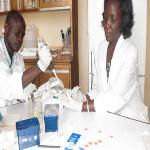New diagnostic tools are being tested that would quickly indicate whether a person has African sleeping sickness. Current methods of diagnosis are slow and cumbersome and delay life-saving treatment.
Health officials say there are no clinical signs of sleeping sickness, also known as African trypanosomiasis. It's often up to health workers to carefully screen those suspected of being infected. If they think a person has the illness, they'll examine the patient's blood under a microscope, looking for parasites.
Dr. Joseph Ndung'u said it simply takes too much time.
"Sleeping sickness has been endemic on the continent of Africa for a long time in 36 countries. The highest epidemics that were occurring recently were 2008 to 2010. At that time it was estimated that at least 500,000 people in these countries were carrying the disease at any one time," he said.
Ndung'u is head of the Human African Trypanosomiasis and Neglected Diseases Program at FIND, the Foundation for Innovative New Diagnostics. He's the former Chief Research Officer at the Kenya Agricultural Research Institute.
He said, "The seriousness of this disease is that any person who gets infected and does not receive treatment eventually dies."
The infection can reach all the way to the brain. All this, from the bite of the tsetse fly.
New Tools
The new diagnostic tools were discussed at the International Scientific Council for Trypanosomiasis Research and Control in Bamako, Mali. One test would be similar to a pregnancy test and could easily be used in the field. That may be ready in 2012.
The other is called Lamp, a machine that can detect the parasite's DNA within 24 hours. It's manufactured by the Japanese company Eiken, which specializes in medical diagnostics.
Dr. Ndung'u said not only can the blood be tested quickly and accurately, but you can see the results with the naked eye. He says if the DNA being tested has fluorescence – that is, emits light – then it's a sure sign the person has African sleeping sickness. The fluorescence results when parasite DNA mixes with chemicals used in the Lamp device.
Now what it means is that we can take a molecular diagnosis, which is normally confined to sophisticated laboratories to laboratories at the district level in the rural areas, where the disease occurs. And therefore can perform these tests closer and be able to detect individuals who are carrying the disease," he said.
He said LAMP can be also used as a follow-up to treatment to determine, if indeed, the treatment was successful. What's more, the machine could be used to test for animal sleeping sickness said to cost African farmers over $4 billion a year. Lamp is expected to be ready for field use in 2012.
Current treatment for sleeping sickness can be toxic. But recently scientists announced a safer method. They combined two chemicals, melarsoprol and cyclodextrin. The new formulation does not need to be injected. It can be taken orally, which allows slower absorption with less toxicity.
Usually, melarsoprol is given alone intravenously in ever increasing doses.
